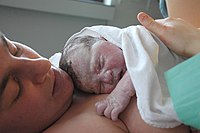
Photo from wikipedia
Background Kangaroo Mother Care (KMC) is an evidence-based intervention recommended by the World Health Organization (WHO) to reduce preterm mortality and morbidity. The aim of this study was to explore… Click to show full abstract
Background Kangaroo Mother Care (KMC) is an evidence-based intervention recommended by the World Health Organization (WHO) to reduce preterm mortality and morbidity. The aim of this study was to explore caregivers’ experiences of providing KMC in hospital settings and after continuation at home in Bangladesh in order to assess enablers and barriers to optimal implementation. Methods Interviews with fifteen caregivers were conducted using an interview guide with semi-structured questions in August 2019 and March 2020. Convenience sampling was used to select hospitals and participants for the study. The inclusion criteria were being a caregiver currently performing KMC in the hospital or having been discharged one week earlier from the KMC ward. The interviews were audio recorded, transcribed verbatim, and translated. The data were analyzed using thematic analysis with an inductive approach. Results Three themes were identified as regards the caregivers’ experiences of providing KMC: conducive conditions, an empowering process, and suboptimal implementation. The results showed that there are supporting circumstances for caregivers performing KMC in Bangladesh, including social support structures and positive attitudes to the method of care. It also appeared that the caregivers felt strengthened in their roles as caregivers by learning and performing KMC. However, the implementation of KMC was suboptimal due to late initiation of KMC, difficulties with keeping the baby skin-to-skin, and pain after cesarean section hampering skin-to-skin practice. Conclusions The social and cultural conditions for the caregivers to perform KMC as well as the empowerment the parents felt in their roles as caregivers when performing KMC are facilitating factors for this method of care. Initial separation and late initiation of KMC, as well as disregard for the mothers’ needs for care and support, were barriers to optimal practice leading to missed opportunities. These facilitators and barriers need to be addressed in order to succeed in scaling up the national KMC program.
Journal Title: PLOS ONE
Year Published: 2023
Link to full text (if available)
Share on Social Media: Sign Up to like & get
recommendations!